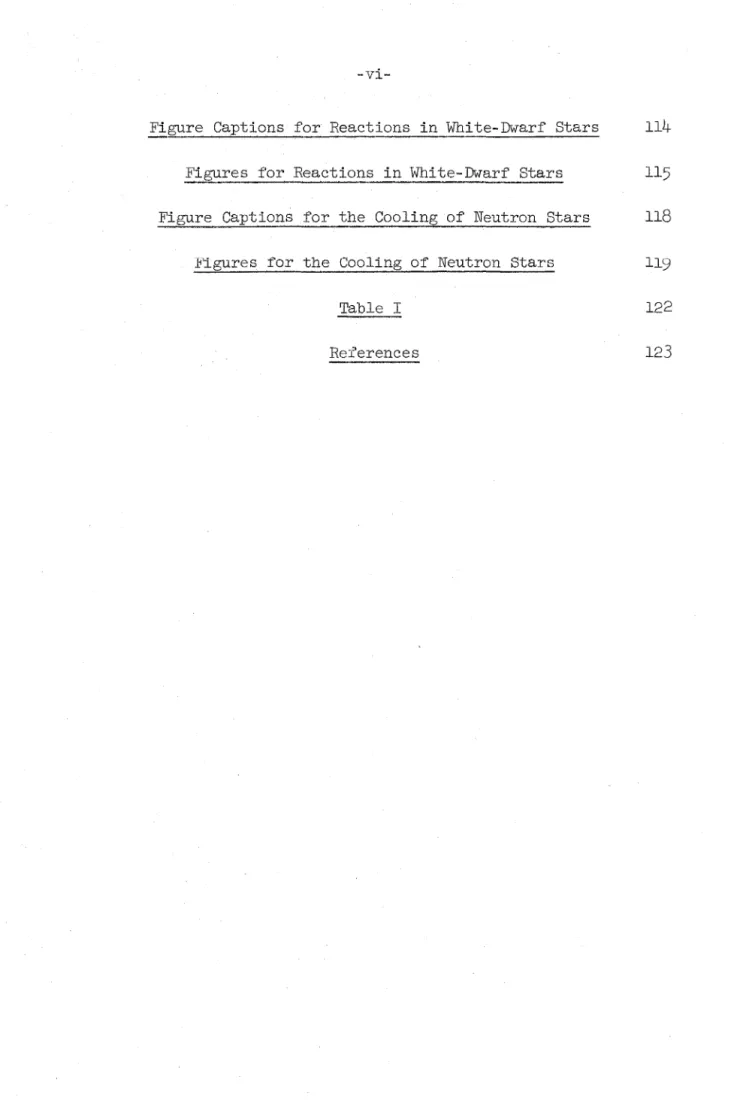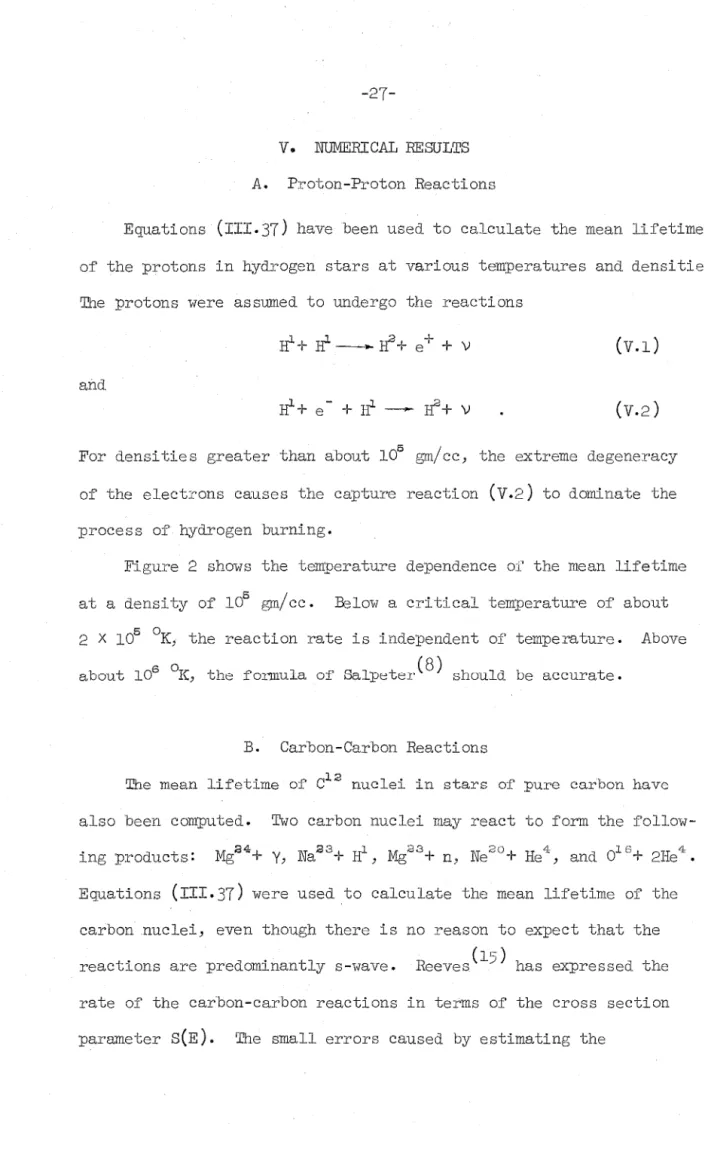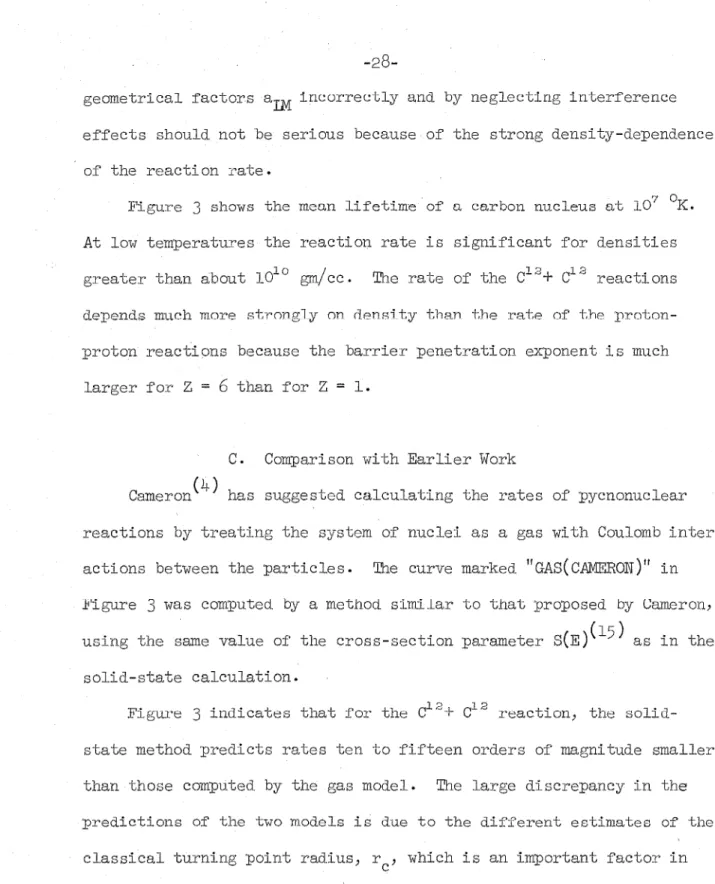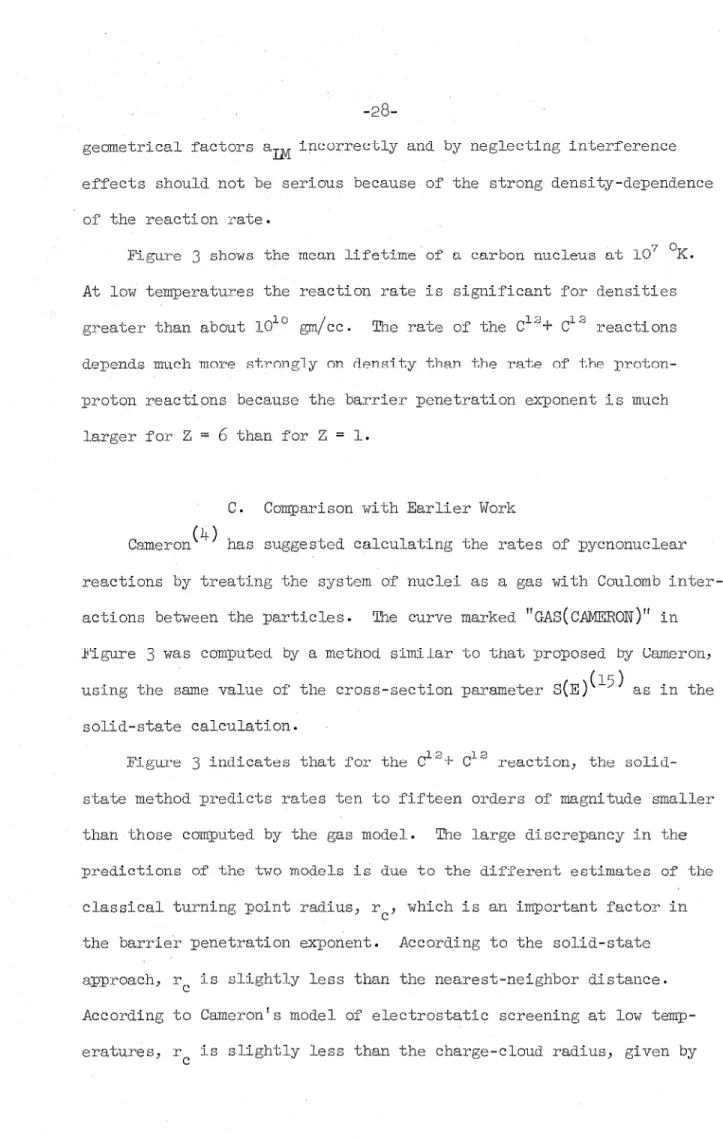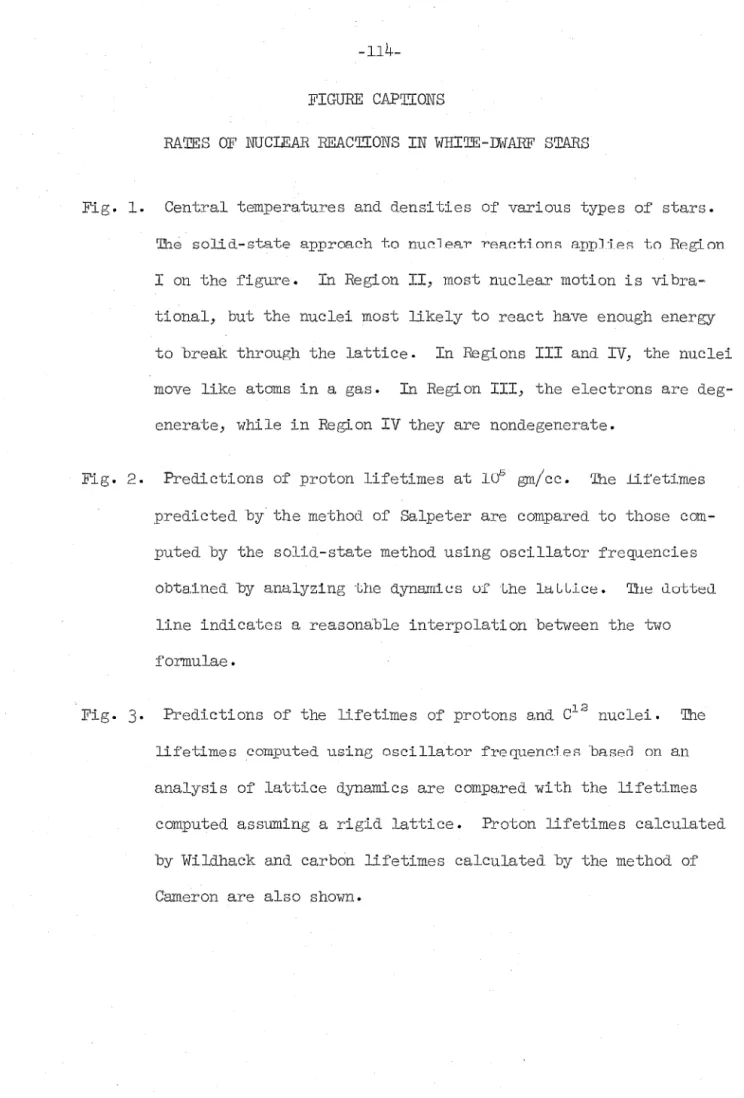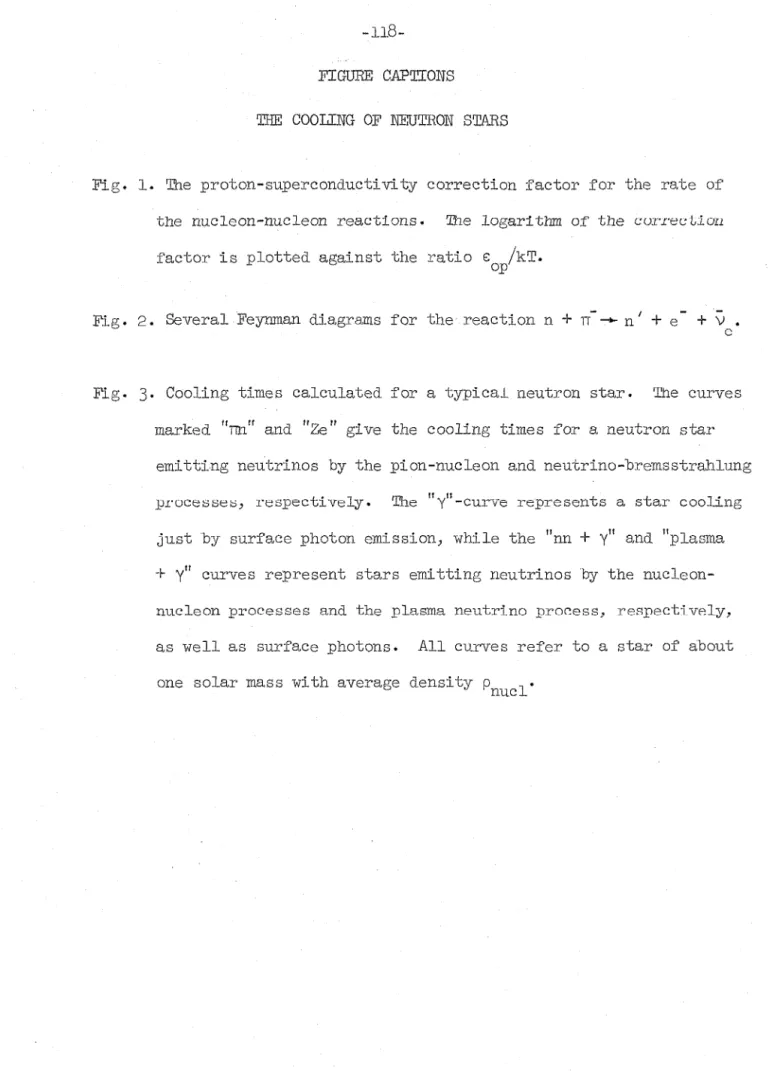In addition, much of the work described here on the cooling of neutron stars is directly due to him. This lower limit on the cooling rate implies that the discrete X-ray sources located towards the galactic center are probably not neutron stars. Knowledge of the rates of pycnonuclear reactions would also be useful in mathematical studies of white dwarfs.
This related problem has recently been considered by Kopyshev (7 \ he calculated the reaction rate .P + p for the case where is small. For small displacements of the nuclei from their equilibrium positions, the potential energy can be written with good accuracy v. The lattice effectively polarizes under movements of two reacting })members.

CALCULATION OF THE REACTION RATE
The right side of F.q. III. l Oa) re};):rAsentR a normalizr::,d three-dimensional harmonic oscillator wave function with frequencies Q, 0 and O and. The effects of the approximations made when deriving Eq. III.l'.;i) can be estimated by examining the WKB barrier-penetration integral. One finds that the most sedous a, approximation involved in Eq. III.15), neglect of € for small and medium, te r, should cause a, n error of less.
The quantity Q gives the ratio of the wave function fL(nz;r) to the Coulomb wave function for the energy E. III.9) to find the reaction rate. We first consider the reaction rate from an initial (n ,n ,n ). III.33b) and rLc(E) is the reaction rate for a pure Coulomb wave with energy E. Equations (III.35) and (III.37) give the inverse lifetime of a nucleus in a solid lattice with density p.
IJ:MITATIONS
THE COOLING OF :NEUTRON STARS I. INTRODUCTION
The thermal photons should be in the X ·ray region due to the high temperatures expected on the surfaces of neutron stars. In the present work we aim to estimate the rate of neutrino emission from neutron star matter. It is still unclear whether quasi-free pions can exist in neutron star matter, because all the relevant binding energies are difficult to calculate.
Then, adopting the particle model once and for all) we discuss in section III the calculation of the number density of the various types of particles in a neutron star, The Fermi-fluid model of neutron-star matter is. But to theoretically derive the detailed properties of a neutron star from knowledge of baryon number and charge, a detailed model must be used. It is easy to put a high-density limit on the usefulness of the particle model.
CONCENTRATIONS OF PARTICLES A. General Discussion
The composition of neutron star matter has been determined in previous work(6),(23) on the basis of the free-particle approximation, the approximation in which the binding energies B. The neutron gas becomes dominant at higher densities, but remains o:t· the original nuclei apparently.Ly persists up to densities of' the order of nuclear density, where they finally. Tet JJ.n' µp, nn' and np represent the chemical potentials and number densities of the neutrons. and protons in neutron star matter. a.re positive it can be shown that the criterion for stability of the uniform neutron-proton gas is the quantities involved in Eq. IV.l) states that the stability criterion is met for densities greater than approximately nuclear.
Bardeen-Cooper-Schrieffer (BCS). between the ground state and the first excited state of the system. Our application of Emery and Sessler's results shows that for a neutron effective mass of 1.0 m the energy · n E: o for a neutron v a. First, the BCS theory has never been successful in predicting observed values of large gaps in superconducting metals or in cores.
However, the ability of BCS theory to predict energy gaps has never been demonstrated. We have based our estimates of energy gaps on the work of Emery and Sessler, who applied only the most direct form of BCS theory to nuclear matter. In particular, they neglected the complication of three-body collisions, the polarization of the neutron medium by protons can make a significant contribution to it.
For a non-relativistic nucleon, the free particle model implies this. v.2) where the mass of the nucleon is missing, the interactions in the energy spectrum of a star can be reproduced a, approximately by writing the energy of each individual nucleon in the form In the next two paragraphs, we describe the general behavior of the effective masses as functions of density, showing the extent to which the numerical results depend on the particular potential chosen. These values of the effective masses will be used in section VIII a, and IX in the calculation of the cooling rates.
The mean free path of an electron neutrino in a neutron star is therefore on the order of 106 times the radius of a neutron star; the mean free path of an electron antineutrino is of the same order of magnitude.
COOLING: GENERAL DISCUSSION AND HEURISTIC CALCULATIONS In order to compute cooling times, one must consider the excited
The main feature of this argument is that only Fermions at the edge of their ca,n degenerate seas undergo elastic scattering, so that only a small fraction of the order of (kT/EF) Fermions of a given type can participate in cooling. reactions. Since esca,p2 neutrinos from a neutron star (see Section VI), this argument does not apply to them. However, the net amount of energy transferred to a neutrino in any of the cooling reactions must, by conservation of energy, be of the order of kT.
We consider the mass M of the neutron star. substance at uniform density panda uniform temperature T. VII-2), we find that the neutrino luminosity due to reaction (I.1) is given by. 0 is the mass of the sun and T9 is the temperature in billions. VII.3) gives a lot of energy, which is not great. differ greatly from the energy losses calculated from our more complex analysis in Sec. VII.3) gives . r.nrrectly th Key' c'Jpppnc'J enr.e nf T,~1 ) to temperature, although the density dependence cannot be obtained correctly without more care. A similar rough argument can be used to obtain an estimate of the energy losses in the reaction (I. 3). Note that the ,process (L 3) contains two fermions less than the ,processes (Ll) and (I.2); so the rate. VII.3a) The heuristic arguments clearly indicate which quantities need to be calculated in the exact analysis, namely the phase space integrals (which we approximated by kT/EF factors) and the nuclear matrix.
NUCLEON-NUCLEON COOLING A. General Expressions
The quantity Sis a product of the Fermi-Dirac distribution functions for every particle appearing in the reaction (I.l), except the neutrino; S corrects the density of state factors for the effect of the exclusion principle on the final state and gives the correct occupation numbers on the initial state. One can isolate the movement of the center of mass of the nucleons in the matrix element (n, p, 'e, V IHI e w n, n) by entering the following coordinates of the center of mass and relative:. We assume that the nucleon-nucleon potential acts only in the equilibrium state; and (2) we disregard all terms that include.
It can be shown that the second simplification leads to errors of the order of 15% if the first is valid. Using the simplifications described above, we square the matrix element and add up all the revolutions, so that we get
The biggest mistake we made in limiting ourselves to the domain described by relations (VIII.10) and (VIII.11) is of the order of magnitude. We now consider the integrations of the lengths of the momentum vectors in Eq. The electron Fermi energy depends on - B the difference p'. between the binding energies of the neutron and the proton.
We must first derive an expression for the rate of energy loss by reaction (I.3), and then modify the formula to take into account the other reactions. As in the case of nucleon–nucleon cooling, we describe the density of accessible initial and final states by the phase-space factor, which for reaction (I.3) is defined in Eq. Therefore, we do not take neutron superfluidity into account in the calculation of the cooling rate in pion reactions.
The range of the pion-nucleon potential is of the order of the scale length "-n. If these physical lengths were the only ones important in M, one would conclude that the dimensionless matrix element is of the order of unity. As in the case of the nucleon-nucleon reactions it can be proved that the rate of energy loss by the inverse processes (reactions (I.7) and (I.8) is equal to the rate of energy loss by the 1. forward processes. (reactions (I .3) and (I.4)).
We note that the energy loss from pionic processes is of the order of 107 'is-2 times greater than the energy loss from nucleon-nucleon processes if a. Consider a system consisting of a mass M of neutron star s. matter of uniform density p and uniform temperature T. The contribution of the neutron gas to the specific heat of the system j_s given approximately by. sends the change that superfluidity causes in specific heat. The rate of change of the internal temperature can be easily calculated (if the ratio of the internal temperature to the surface is known) using the relation.
In her thesis, Ms. Tsuruta (Ref. 6) used the general expressions for the rate of the plasma neutrino process given by J. Therefore, we conclude that the sources towards the galactic center are not neutron stars. As for reactions involving quasi-free pions, we can use some of the arguments from the last few sections to show that the .
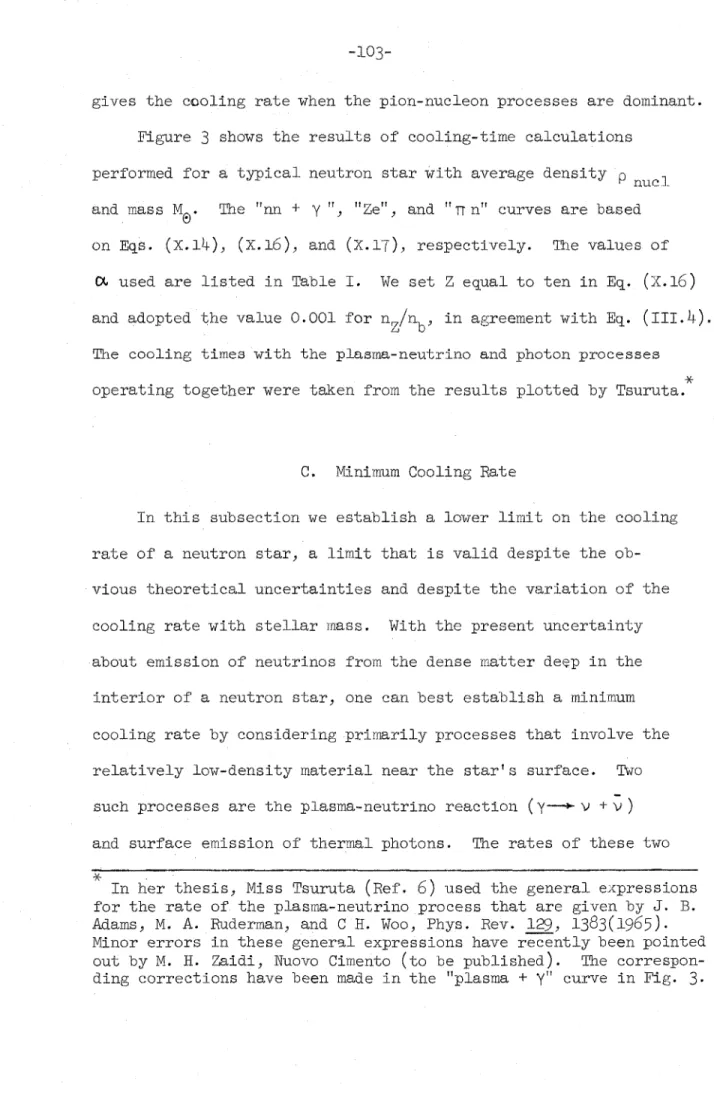
SOLID
NON-DEGENERAT GAS
TEMPERATURE, °K)
DYNAMIC SOLID
PROTON LIFETIMES
TEMPERATURE ,°K)
DENSITY, gm/cc)
The curves marked 1tnnrr and times for a neutron star emitting neutrinos through the pion nucleon and neutrino bremsstrahlung.

